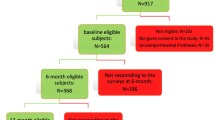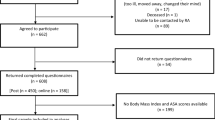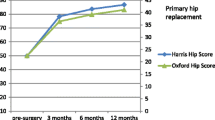Abstract
Purpose
As patient-reported outcome measures (PROMs) are increasingly integrated into clinical practice, there is a need to translate collected data into valuable information to guide and improve the quality and value of patient care. The purpose of this study was to investigate health-related quality-of-life (QoL) trajectories in the 5 years following total knee replacement (TKR) and the patient characteristics associated with these trajectories. The feasibility of translating QoL trajectories into valuable information for guiding patient-centered care was also explored.
Methods
Data on patients who underwent TKR between 2006 and 2011 from a single-institution registry were extracted including patient-reported QoL (captured using the Short Form Survey (SF-12) instrument) up to 5 years post-surgery. QoL trajectories were modelled using latent class growth analysis. Quality-adjusted life-years (QALYs) were calculated to illustrate longer term health benefit. Multinomial logistic regression analyses were performed to examine the association between trajectory groups and baseline patient characteristics.
Results
After exclusions, 1553 patients out of 1892 were included in the analysis. Six unique QoL trajectories were identified; with differing levels at baseline and improvement patterns post-surgery. Only 18.4% of patients were identified to be in the most positive QoL trajectory (low baseline, large sustainable improvement after surgery) associated with the greatest gain in QALY. These patients were likely to be younger, have no co-morbidities and report greater pain at pre-surgery than most in other QoL trajectories.
Conclusions
Our findings demonstrate the importance of underlying heterogeneity in QoL trajectories, resulting in variable QALY gains. There is scope in translating routinely collected PROMs to improve shared decision-making allowing for more patient engagement. However, further research is required to identify suitable approaches of its implementation into practice to guide clinical care and maximize patient outcomes.

Similar content being viewed by others
References
Smith, A. B., & Schwarze, M. L. (2017). Translating patient-reported outcomes from surgical research to clinical care. JAMA Surgery., 152(9), 811–812.
Black, N. (2013). Patient reported outcome measures could help transform healthcare. BMJ : British Medical Journal., 346, f167.
Van Der Wees, P. J., Van Der Sanden, M. W. N., Ayanian, J. Z., Black, N., Westert, G. P., & Schneider, E. C. (2014). Integrating the use of patient-reported outcomes for both clinical practice and performance measurement: Views of experts from 3 countries. The Milbank Quarterly., 92(4), 754–75.
Aaronson, N. K., & Snyder, C. (2008). Using patient-reported outcomes in clinical practice: Proceedings of an international society of quality of life research conference. Quality of Life Research, 17(10), 1295.
Austin, E., LeRouge, C., Hartzler, A. L., Segal, C., & Lavallee, D. C. (2020). Capturing the patient voice: Implementing patient-reported outcomes across the health system. Quality of Life Research., 29(2), 347–355.
Hsiao, C.-J., Dymek, C., Kim, B., & Russell, B. (2019). Advancing the use of patient-reported outcomes in practice: Understanding challenges, opportunities, and the potential of health information technology. Quality of Life Research., 28(6), 1575–1583.
Baker, P., Muthumayandi, K., Gerrand, C., Kleim, B., Bettinson, K., & Deehan, D. (2013). Influence of body mass index (BMI) on functional improvements at 3 years following total knee replacement: A retrospective cohort study. PLoS ONE, 8(3), e59079.
Nilsdotter, A.-K., Toksvig-Larsen, S., & Roos, E. (2009). A 5 year prospective study of patient-relevant outcomes after total knee replacement. Osteoarthritis and Cartilage., 17(5), 601–606.
Schilling, C., Dowsey, M. M., Clarke, P. M., & Choong, P. F. (2016). Using patient-reported outcomes for economic evaluation: Getting the timing right. Value in Health., 19(8), 945–950.
Dakin H, Gray A, Fitzpatrick R, MacLennan G, Murray D, Group KT. (2012). Rationing of total knee replacement: A cost-effectiveness analysis on a large trial data set. British Medical Journal Open, 2(1), e000332.
Dowsey, M., Smith, A., & Choong, P. (2015). Latent class growth analysis predicts long term pain and function trajectories in total knee arthroplasty: A study of 689 patients. Osteoarthritis and Cartilage., 23(12), 2141–2149.
Alzahrani, K., Gandhi, R., Petruccelli, D., & Mahomed, N. (2011). Prevalence of clinically significant improvement following total knee replacement. The Journal of Rheumatology., 38(4), 753–759.
Quintana, J. M., Escobar, A., Arostegui, I., Bilbao, A., Azkarate, J., Goenaga, J. I., et al. (2006). Health-related quality of life and appropriateness of knee or hip joint replacement. Archives of Internal Medicine., 166(2), 220–226.
Lange, J. K., DiSegna, S. T., Yang, W., Li, W., & Franklin, P. D. (2019). Using cluster analysis to identify patient factors linked to differential functional gains after total knee arthroplasty. The Journal of Arthroplasty., 35, 121.
Clarke, P. M., Hayes, A. J., Glasziou, P. G., Scott, R., Simes, J., & Keech, A. C. (2009). Using the EQ-5D index score as a predictor of outcomes in patients with type 2 diabetes. Medical Care., 47(1), 61–68.
Mapes, D. L., Lopes, A. A., Satayathum, S., Mccullough, K. P., Goodkin, D. A., Locatelli, F., et al. (2003). Health-related quality of life as a predictor of mortality and hospitalization: The dialysis outcomes and practice patterns study (DOPPS). Kidney International., 64(1), 339–349.
Ediebah, D. E., Quinten, C., Coens, C., Ringash, J., Dancey, J., Zikos, E., et al. (2018). Quality of life as a prognostic indicator of survival: A pooled analysis of individual patient data from canadian cancer trials group clinical trials. Cancer, 124(16), 3409–3416.
Hansen, T. B., Thygesen, L. C., Zwisler, A. D., Helmark, L., Hoogwegt, M., Versteeg, H., et al. (2015). Self-reported health-related quality of life predicts 5-year mortality and hospital readmissions in patients with ischaemic heart disease. European Journal of Preventive Cardiology., 22(7), 882–889.
Obama, B. (2016). United States health care reform: Progress to date and next steps. JAMA, 316(5), 525–532.
Spertus, J. A., & Ghaferi, A. A. (2017). Transforming the national surgical quality improvement program to the delivery of precision medicine to improve the value of surgical care: Summary of the John R. Clarke Keynote address for the surgical outcomes club 2016 annual meetingtransforming NSQIP to the delivery of precision medicinetransforming NSQIP to the delivery of precision medicine. JAMA Surgery., 152(9), 815–6.
McDermott, K., Freeman, W., & Elixhauser, A. (2017). Overview of operating room procedures during inpatient stays in US hospitals, 2014. HCUP Statistical Brief., 233, 1–18.
Dowsey, M. M., Spelman, T., & Choong, P. F. (2016). Development of a prognostic nomogram for predicting the probability of nonresponse to total knee arthroplasty 1 year after surgery. Journal of Arthroplasty, 31(8), 1654–1660.
Tew M, Dalziel K, Dowsey M, Choong PF, Clarke P. Exploring the impact of quality of life on survival: A case study in total knee replacement surgery. Medical Decision Making. 2020:0272989X20913266.
Australian Bureau of Statistics. Information Paper: An Introduction to Socio-Economic Indexes for Areas (SEIFA)—2039.0. 2006. Retreived May 10, 2019 from https://www.abs.gov.au/ausstats/abs@.nsf/mf/2039.0
Australian Bureau of Statistics. Australian Statistical Geography Standard (ASGS): Volume 5—Remoteness Structure—1270.0.55.005. 2016 . Retreived May 10, 2019 from https://www.abs.gov.au/ausstats/abs@.nsf/mf/1270.0.55.005?OpenDocument
Kellgren, J. H., & Lawrence, J. S. (1957). Radiological assessment of osteo-arthrosis. Annals of the Rheumatic Diseases., 16(4), 494–502.
Insall, J. N., Dorr, L. D., Scott, R. D., & Scott, W. N. (1989). Rationale of the knee society clinical rating system. Clinical Orthopaedics and Related Research., 248, 13–14.
Brazier, J. E., & Roberts, J. (2004). The estimation of a preference-based measure of health from the SF-12. Medical Care., 42, 851–9.
Andruff, H., Carraro, N., Thompson, A., Gaudreau, P., & Louvet, B. (2009). Latent class growth modelling: A tutorial. Tutorials in Quantitative Methods for Psychology., 5(1), 11–24.
Jones, B. L., Nagin, D. S., & Roeder, K. (2001). A SAS procedure based on mixture models for estimating developmental trajectories. Sociological Methods & Research., 29(3), 374–393.
Nagin, D. S., & Odgers, C. L. (2010). Group-based trajectory modeling in clinical research. Annual Review of Clinical Psychology., 6, 109–138.
Nagin, D. S., & Nagin, D. (2005). Group-based modeling of development. Cambridge: Harvard University Press.
Sanders, G. D., Neumann, P. J., Basu, A., Brock, D. W., Feeny, D., Krahn, M., et al. (2016). Recommendations for conduct, methodological practices, and reporting of cost-effectiveness analyses: Second panel on cost-effectiveness in health and medicine. JAMA, 316(10), 1093–1103.
Hunter, R. M., Baio, G., Butt, T., Morris, S., Round, J., & Freemantle, N. (2015). An educational review of the statistical issues in analysing utility data for cost-utility analysis. Pharmacoeconomics., 33(4), 355–366.
Jenkins, P., Clement, N., Hamilton, D., Gaston, P., Patton, J., & Howie, C. (2013). Predicting the cost-effectiveness of total hip and knee replacement: A health economic analysis. Bone Joint Journal., 95(1), 115–121.
Richardson, G., & Manca, A. (2004). Calculation of quality adjusted life years in the published literature: A review of methodology and transparency. Health Economics., 13(12), 1203–1210.
Schilling, C. G., Dowsey, M. M., Petrie, D. J., Clarke, P. M., & Choong, P. F. (2017). Predicting the long-term gains in health-related quality of life after total knee arthroplasty. The Journal of Arthroplasty., 32(2), 395.
Waimann, C. A., Fernandez-Mazarambroz, R. J., Cantor, S. B., Lopez-Olivo, M. A., Zhang, H., Landon, G. C., et al. (2014). Cost-effectiveness of total knee replacement: A prospective cohort study. Arthritis Care & Research., 66(4), 592–599.
Lavallee, D. C., Chenok, K. E., Love, R. M., Petersen, C., Holve, E., Segal, C. D., et al. (2016). Incorporating patient-reported outcomes into health care to engage patients and enhance care. Health Affairs (Project Hope)., 35(4), 575–582.
Cross, M., Lapsley, H., Barcenilla, A., Parker, D., Coolican, M., & March, L. (2009). Patient Expectations of hip and knee joint replacement surgery and postoperative health status. The Patient: Patient-Centered Outcomes Research., 2(1), 51–60.
Miller, J. L., Teare, S. R., Marlett, N., Shklarov, S., & Marshall, D. A. (2016). Support for living a meaningful life with osteoarthritis: A patient-to-patient research study. The Patient-Patient-Centered Outcomes Research., 9(5), 457–464.
Dhatariya, K., Levy, N., Kilvert, A., Watson, B., Cousins, D., Flanagan, D., et al. (2012). NHS Diabetes guideline for the perioperative management of the adult patient with diabetes. Diabetic Medicine., 29(4), 420–433.
Dowsey, M., Castle, D., Knowles, S., Monshat, K., Salzberg, M., Nelson, E., et al. (2019). The effect of mindfulness training prior to total joint arthroplasty on post-operative pain and physical function: A randomised controlled trial. Complementary Therapies in Medicine., 46, 195–201.
Davis, A. M., Kennedy, D., Wong, R., Robarts, S., Skou, S. T., McGlasson, R., et al. (2018). Cross-cultural adaptation and implementation of Good Life with osteoarthritis in Denmark (GLA:D™): Group education and exercise for hip and knee osteoarthritis is feasible in Canada. Osteoarthritis and Cartilage., 26(2), 211–219.
Fransen M, McConnell S, Harmer AR, Van der Esch M, Simic M, Bennell KL. Exercise for osteoarthritis of the knee. Cochrane Database of Systematic Reviews. 2015(1).
Skou, S. T., & Roos, E. M. (2017). Good Life with osteoArthritis in Denmark (GLA: D™): Evidence-based education and supervised neuromuscular exercise delivered by certified physiotherapists nationwide. BMC Musculoskeletal Disorders., 18(1), 72.
Jones, A. R., Al-Naseer, S., Bodger, O., James, E. T. R., & Davies, A. P. (2018). Does pre-operative anxiety and/or depression affect patient outcome after primary knee replacement arthroplasty? The Knee., 25(6), 1238–1246.
Riddle, D. L., Wade, J. B., Jiranek, W. A., & Kong, X. (2010). Preoperative pain catastrophizing predicts pain outcome after knee arthroplasty. Journal Clinical Orthopaedics and Related Research®, 468(3), 798–806.
Vissers, M. M., Bussmann, J. B., Verhaar, J. A., Busschbach, J. J., Bierma-Zeinstra, S. M., & Reijman, M. (2012). Psychological factors affecting the outcome of total hip and knee arthroplasty: A systematic review. Seminars in Arthritis and Rheumatism, 41, 576–588.
Dumenci, L., Perera, R., Keefe, F., Ang, D., Slover, J., Jensen, M., et al. (2019). Model-based pain and function outcome trajectory types for patients undergoing knee arthroplasty: A secondary analysis from a randomized clinical trial. Osteoarthritis and Cartilage., 27, 878.
Lenguerrand, E., Wylde, V., Gooberman-Hill, R., Sayers, A., Brunton, L., Beswick, A. D., et al. (2016). Trajectories of pain and function after primary hip and knee arthroplasty: The ADAPT cohort study. PLoS ONE, 11(2), e0149306.
Bayliss, L. E., Culliford, D., Monk, A. P., Glyn-Jones, S., Prieto-Alhambra, D., Judge, A., et al. (2017). The effect of patient age at intervention on risk of implant revision after total replacement of the hip or knee: A population-based cohort study. The Lancet., 389(10077), 1424–1430.
Kurtz, S. M., Lau, E., Ong, K., Zhao, K., Kelly, M., & Bozic, K. J. (2009). Future young patient demand for primary and revision joint replacement: National projections from 2010 to 2030. Clinical Orthopaedics and Related Research., 467(10), 2606–2612.
Goh, G. S.-H., Liow, M. H. L., Abd Razak, H. R. B., Tay, D. K.-J., Lo, N.-N., & Yeo, S.-J. (2017). Patient-reported outcomes, quality of life, and satisfaction rates in young patients aged 50 years or younger after total knee arthroplasty. The Journal of Arthroplasty., 32(2), 419–25.
Evans, J. T., Walker, R. W., Evans, J. P., Blom, A. W., Sayers, A., & Whitehouse, M. R. (2019). How long does a knee replacement last? A systematic review and meta-analysis of case series and national registry reports with more than 15 years of follow-up. The Lancet., 393(10172), 655–663.
Halawi, M. J., Cote, M. P., Savoy, L., Williams, V. J., & Lieberman, J. R. (2019). The effect of payer type on patient-reported outcomes in total joint arthroplasty is modulated by baseline patient characteristics. The Journal of Arthroplasty., 34(6), 1072–1075.
Kent, D. M., & Hayward, R. A. (2007). Limitations of applying summary results of clinical trials to individual patients the need for risk stratification. JAMA, 298(10), 1209–1212.
Riddle, D. L., Jiranek, W. A., & Hayes, C. W. (2014). Use of a validated algorithm to judge the appropriateness of total knee arthroplasty in the United States: A multicenter longitudinal cohort study. Arthritis & Rheumatology (Hoboken, NJ)., 66(8), 2134–2143.
Escobar, A., Quintana, J. M., Aróstegui, I., Azkárate, J., Güenaga, J. I., Arenaza, J. C., et al. (2003). Development of explicit criteria for total knee replacement. International Journal of Technology Assessment in Health Care., 19(1), 57–70.
Groot, W. (2000). Adaptation and scale of reference bias in self-assessments of quality of life. Journal of Health Economics., 19(3), 403–420.
Australian Orthopaedic Association National Joint Replacement Registry (AOANJRR). Hip, Knee & Shoulder Arthroplasty Annual Report 2018. Adelaide: AOA; 2018. Retrieved April 24, 2019
Xuan, J., Kirchdoerfer, L. J., Boyer, J. G., & Norwood, G. J. (1999). Effects of comorbidity on health-related quality-of-life scores: An analysis of clinical trial data. Clinical Therapeutics., 21(2), 383–403.
Sprangers, M. A. G., & Schwartz, C. E. (1999). Integrating response shift into health-related quality of life research: A theoretical model. Social Science & Medicine., 48(11), 1507–1515.
Razmjou, H., Schwartz, C. E., Yee, A., & Finkelstein, J. A. (2009). Traditional assessment of health outcome following total knee arthroplasty was confounded by response shift phenomenon. Journal of Clinical Epidemiology., 62(1), 91–96.
Zhang, X.-H., Li, S.-C., Xie, F., Lo, N.-N., Yang, K.-Y., Yeo, S.-J., et al. (2012). An exploratory study of response shift in health-related quality of life and utility assessment among patients with osteoarthritis undergoing total knee replacement surgery in a tertiary hospital in Singapore. Value in Health., 15(1), S72–S8.
Razmjou, H., Yee, A., Ford, M., & Finkelstein, J. A. (2006). Response shift in outcome assessment in patients undergoing total knee arthroplasty. JBJS., 88(12), 2590–2595.
Schilling, C., Petrie, D., Dowsey, M. M., Choong, P. F., & Clarke, P. (2017). The impact of regression to the mean on economic evaluation in quasi-experimental pre–post studies: The example of total knee replacement using data from the osteoarthritis initiative. Health Economics., 26(12), e35–e51.
Acknowledgements
A version of this paper was previously presented to the July 2019 meeting of the Health Economists’ Study Group. We would like to thank Catherine Henderson and others present who commented on the paper.
Funding
This study was supported by the Australian National Health and Medical Research Council (NHMRC) funded Centre for Research Excellence in Total Joint Replacement (1116325). Michelle Dowsey holds a National Health and Medical Research Council of Australia Career Development Fellowship (1122526). Peter Choong holds a National Health and Medical Research Council of Australia Practitioner Fellowship (1154203). Peter Choong, Michelle Dowsey, Anne Smith and Philip Clarke are recipients of a National Health and Medical Research Council Centre for Research Excellence Grant in Total Joint Replacement (1116325). Michelle Tew is jointly supported by the NHMRC funded Centre for Research Excellence in Total Joint Replacement (1116325) and Centre for Improving Cancer Outcomes Through Enhanced Infection Services (1116876), Melbourne Research Scholarship and Australian Research Council Centre of Excellence in Population Ageing Research.
Author information
Authors and Affiliations
Corresponding author
Ethics declarations
Conflicts of interest
None reported for Philip Clarke, Kim Dalziel, Anne Smith and Michelle Tew. Dr. Dowsey reports grants from National Health & Medical Research Council, during the conduct of the study; grants from Medacta International, grants from Medibank Foundation and grants from MSK Australia outside of the submitted work. Professor Chong reports grants from National Health & Medical Research Council during the conduct of the study; fees from Stryker Corporation and Depuy, Johnson & Johnson outside of the submitted work.
Ethics approval
This study was approved by the St. Vincent’s Hospital Melbourne Human Research Ethics Committee (HREC) (LNR/17/SVHM/136).
Informed consent
This study involved the use of anonymised data extracted from a registry and was granted a waiver of informed consent.
Additional information
Publisher's Note
Springer Nature remains neutral with regard to jurisdictional claims in published maps and institutional affiliations.
Electronic supplementary material
Below is the link to the electronic supplementary material.
Rights and permissions
About this article
Cite this article
Tew, M., Dalziel, K., Clarke, P. et al. Patient-reported outcome measures (PROMs): can they be used to guide patient-centered care and optimize outcomes in total knee replacement?. Qual Life Res 29, 3273–3283 (2020). https://doi.org/10.1007/s11136-020-02577-4
Accepted:
Published:
Issue Date:
DOI: https://doi.org/10.1007/s11136-020-02577-4




